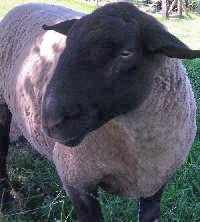Romance - Sheep Style

Have you ever thought about designing book covers for ewes? A steamy romance with Fabio the ram standing on a windswept hilltop, his chest fleece poking provocatively from his unbuttoned shirt…
Well, if you did - and I suspect that a few of you might be doing so now - there’s one essential element you’d have to include - scratch and sniff. Because, for sheep, lurve isn’t in the eye of the beholder, it’s in the nose.
Or so we thought.
It’s tupping time on the smallholding and this year we’ve retired three of our older ewes and brought in some new blood. Our ram, Harmon, who we keep in a separate paddock until he’s needed, has been getting ready for the last couple of months, pacing the fence line, curling his lip back in anticipation, and … greasing up.
Greasing is a ram thing. They start to produce a musky grease in September. It stinks. It breaks out as liquid beads on his head, chest and armpits. And the closer the breeding season comes, the more he produces. By October you can smell him from twenty feet away. If you need to lift him - which you might for foot trimming - you try to avoid placing your hands anywhere near his armpits or they will come out slicked in grease.
But the ewes go crazy for it. Forget tall, dark and handsome. Short, greasy and smelly does it every time.
So, two weeks ago we raddled our ram - which is sheep talk for applying liberal amounts of coloured wax to his chest so that any ewe he mates with will have a coloured patch of fleece on her rear end. It makes it easy to see who’s been covered and calculate the date they should lamb. And to make sure every ewe’s in lamb you change the raddle colour every 14 days. Ewes cycle every 16-17 days and only go to the ram on the days they’re in season so a ewe with a multicoloured rear end is a problem - something ain’t working. Or the grease is working too well:)
Anyway, freshly raddled with L’Oreal’s finest, Harmon burst out of the gate. He chased, he head-butted, he curled his top lip back, he sniffed. He spent two whirlwind days with our last remaining older ewe. Then nothing.
One of the new ewes came into season and pursued him all over the field. She head-butted him. She threw herself at him. But he chased her off. He didn’t want anything to do with her.
Which is when we started to panic. All the new ewes were black-faced. The old ewes had been white-faced. Except one - Black Ewe. She’d lambed successfully with our previous ram but had spent two years with Harmon without mating once. We’d assumed the problem was with her and had even put her on fertility treatment. But now we began to wonder. Did Harmon - a black-faced Suffolk - have a problem with black-faced ewes?
Had #racefail struck our paddock?
Things did not look good. For spring lambs or for Harmon. A ram who wouldn’t touch 80% of our flock was not a ram with a bright future. And it was getting late to bring on a replacement.
So… time to think creatively. Could we whiten the sheep? Maybe dust their faces with flour? But was that racist? Should we sit Harmon down and have a serious talk with him?
We dithered for four days, putting questions on animal bulletin boards. Had anyone encountered anything similar? No one replied. I had the flour ready. Then… the next black-headed ewe came into season and Harmon reacted immediately. He chased her everywhere. This time it was the ewe that didn’t want anything to do with him. Not after the way you treated my sister!
For one whole day she ran and he chased. Both were out of breath, both needed long lie-downs. Then the next morning we awoke to find the two of them inseparable and a copious amount of purple dye.
He’s since wined, dined, and tupped another of our new ewes so maybe he’s got over his problem. The big test will be next week when the first ewe comes back into season. Maybe he’s just not that into her?
Next week: Why wives should raddle their husbands, by Elin Nordegren